Downloaded from SAE International by rock hsu, Wednesday, June 27, 2018
SURFACE VEHICLE
RECOMMENDED PRACTICE
J3016™
JUN2018
Issued
Revised
Superseding J3016 SEP2016
2014-01
2018-06
(R) Taxonomy and Definitions for Terms Related to Driving Automation
Systems for On-Road Motor Vehicles
RATIONALE
This revision of Recommended Practice J3016 adds several new terms and definitions, corrects a few errors, and adds
further clarification (especially in Section 8) to address frequently misunderstood concepts. As in the previous version, it
fgfunctional definitions for advanced levels of driving automation and related terms and definitions. This Recommended
Practice does not provide specifications, or otherwise impose requirements on, driving automation systems (for further
elaboration, see 8.1). Standardiz31ing levels of driving automation and supporting terms serves several purposes, including:
1. Clarifying the role of the (human) driver, if any, during driving automation system engagement.
2. Answering questions of scope when it comes to developing laws, policies, regulations, and standards.
3. Providing a useful framework for driving automation specifications and technical requirements.
4. Providing clarity and stability in communications on the topic of driving automation, as well as a useful short-hand that
saves considerable time and effort.
This document has been developed according to the following guiding principles, namely, it should:
1. Be descriptive and informative rather than normative.
2. Provide functional definitions.
3. Be consistent with current industry practice.
4. Be consistent with prior art to the extent practicable.
5. Be useful across disciplines, including engineering, law, media, public discourse.
6. Be clear and cogent and, as such, it should avoid or define ambiguous terms.
__________________________________________________________________________________________________________________________________________
SAE Technical Standards Board Rules provide that: “This report is published by SAE to advance the state of technical and engineering sciences. The use of this report is entirely
voluntary, and its applicability and suitability for any particular use, including any patent infringement arising therefrom, is the sole responsibility of the user.”
SAE reviews each technical report at least every five years at which time it may be revised, reaffirmed, stabilized, or cancelled. SAE invites your written comments and
suggestions.
Copyright © 2018 SAE International
All rights reserved. No part of this publication may be reproduced, stored in a retrieval system or transmitted, in any form or by any means, electronic, mechanical, photocopying,
recording, or otherwise, without the prior written permission of SAE. SAE hereby grants a limited, royalty free license to any interested person or entity to print or download from
the SAE International website, and then store and display, a single copy of this publication in paper form or in electronic form on a website, computer, or e-room for reference,
reading or review by any interested person or entity provided this notice appears on the publication and the publication cannot be, or is prohibited from being, removed, recorded,
copied, downloaded, printed, or transmitted.
TO PLACE A DOCUMENT ORDER:
SAE WEB ADDRESS:
Tel: 877-606-7323 (inside USA and Canada)
Tel: +1 724-776-4970 (outside USA)
Fax: 724-776-0790
Email: CustomerService@sae.org
http://www.sae.org
SAE values your input. To provide feedback
on this Technical Report, please visit
http://standards.sae.org/J2016_201806
�
Downloaded from SAE International by rock hsu, Wednesday, June 27, 2018
Page 2 of 35
SAE INTERNATIONAL
The document contains updates that reflect lessons learned from various stakeholder discussions, as well as from research
projects conducted in Europe and the United States by the AdaptIVe Project and by the Crash Avoidance Metrics
Partnership (CAMP) Automated Vehicle Research (AVR) Consortium, respectively.
J3016™ JUN2018
Italicized terms used in this Recommended Practice are also defined herein. Bracketed text within a term name indicates
optional inclusion when using term (i.e., braketed text may be unncessary, given the usage context).
1. SCOPE
This S A E Recommended Practice describes motor vehicle driving automation systems that perform part or all of the
dynamic driving task (DDT) on a sustained basis. It provides a taxonomy with detailed definitions for six levels of driving
automation, ranging from no driving automation (level 0) to full driving automation (level 5), in the context of motor vehicles
(hereafter also referred to as “vehicle” or “vehicles”) and their operation on roadways. These level definitions, along with
additional supporting terms and definitions provided herein, can be used to describe the full range of driving automation
features equipped on motor vehicles in a functionally consistent and coherent manner. “On-road” refers to publicly
accessible roadways (including parking areas and private campuses that permit public access) that collectively serve
users of vehicles of all classes and driving automation levels (including no driving automation), as well as motorcyclists,
pedal cyclists, and pedestrians.
The levels apply to the driving automation feature(s) that are engaged in any given instance of on-road operation of an
equipped vehicle. As such, although a given vehicle may be equipped with a driving automation system that is capable
of delivering multiple driving automation features that perform at different levels, the level of driving automation exhibited
in any given instance is determined by the feature(s) that are engaged.
This document also refers to three primary actors in driving: the (human) user, the driving automation system, and other
vehicle systems and components. These other vehicle systems and components (or the vehicle in general terms) do not
include the driving automation system in this model, even though as a practical matter a driving automation system may
actually share hardware and software components with other vehicle systems, such as a processing module(s) or operating
code.
The levels of driving automation are defined by reference to the specific role played by each of the three primary actors in
performance of the DDT and/or DDT fallback. “Role” in this context refers to the expected role of a given primary actor,
based on the design of the driving automation system in question and not necessarily to the actual performance of a given
primary actor. For example, a driver who fails to monitor the roadway during engagement of a level 1 adaptive cruise control
(ACC) system still has the role of driver, even while s/he is neglecting it.
Active safety systems, such as electronic stability control and automated emergency braking, and certain types of driver
assistance systems, such as lane keeping assistance, are excluded from the scope of this driving automation taxonomy
because they do not perform part or all of the DDT on a sustained basis and, rather, merely provide momentary intervention
during potentially hazardous situations. Due to the momentary nature of the actions of active safety systems, their
intervention does not change or eliminate the role of the driver in performing part or all of the DDT, and thus are not
considered to be driving automation.
It should, however, be noted that crash avoidance features, including intervention-type active safety systems, may be
included in vehicles equipped with driving automation systems at any level. For Automated Driving System (ADS) features
(i.e., levels 3-5) that perform the complete DDT, crash avoidance capability is part of ADS functionality.
�
SAE INTERNATIONAL
2. REFERENCES
Downloaded from SAE International by rock hsu, Wednesday, June 27, 2018
J3016™ JUN2018
Page 3 of 35
The following publications form a part of this specification to the extent specified herein. Unless otherwise indicated, the
latest issue of SAE publications shall apply.
2.1 Applicable Documents
ANSI D16.1-2007 Manual on Classification of Motor Vehicle Traffic Accidents
SAE J670
Vehicle Dynamics Terminology (J670:JAN2008)
SAE J3063
Active Safety Systems Terms & Definitions (J3063:NOV2015)
49 U.S.C. § 30102(a)(6) (definition of motor vehicle)
Gasser, Tom et al., “Legal consequences of an increase in vehicle automation”, July 23, 2013, available at
http://bast.opus.hbz-nrw.de/volltexte/2013/723/pdf/Legal_consequences_of_an_increase_in_vehicle_automation.pdf.
Michon, J.A., 1985. A CRITICAL VIEW OF DRIVER BEHAVIOR MODELS: WHAT DO WE KNOW, WHAT SHOULD WE
DO? In L. Evans & R. C. Schwing (Eds.). Human behavior and traffic safety (pp. 485-520). New York: Plenum Press,
1985.
Crash Avoidance Metrics Partnership – Automated Vehicle Research Consortium, “Automated Vehicle Research for
Enhanced Safety – Final Report,” available at https://www.regulations.gov/document?D=NHTSA-2014-0070-0003.
Smith, Bryant Walker. Engineers and Lawyers Should Speak the Same Robot Language, in ROBOT LAW (2015), available
at https://newlypossible.org.
3. DEFINITIONS
3.1 ACTIVE SAFETY SYSTEM (SAE J3063:NOV2015)
Active safety systems are vehicle systems that sense and monitor conditions inside and outside the vehicle for the purpose
of identifying perceived present and potential dangers to the vehicle, occupants, and/or other road users, and automatically
intervene to help avoid or mitigate potential collisions via various methods, including alerts to the driver, vehicle system
adjustments, and/or active control of the vehicle subsystems (brakes, throttle, suspension, etc.).
NOTE:
For purposes of this report, systems that meet the definition of active safety systems are considered to
have a design purpose that is primarily focused on improving safety rather than comfort, convenience or
general driver assistance. Active safety systems warn or intervene during a high-risk event or maneuver.
3.2 AUTOMATED DRIVING SYSTEM (ADS)
The hardware and software that are collectively capable of performing the entire DDT on a sustained basis, regardless of
whether it is limited to a specific operational design domain (ODD); this term is used specifically to describe a level 3, 4, or
5 driving automation system.
NOTE:
In contrast to ADS, the generic term “driving automation system” (see 3.8) refers to any level 1-5 system or
feature that performs part or all of the DDT on a sustained basis. Given the similarity between the generic
term, “driving automation system,” and the level 3-5-specific term, “Automated Driving System,” the latter
term should be capitalized when spelled out and reduced to its acronym, ADS, as much as possible, while
the former term should not be.
�
SAE INTERNATIONAL
3.3 ADS-DEDICATED VEHICLE (ADS-DV)
Downloaded from SAE International by rock hsu, Wednesday, June 27, 2018
J3016™ JUN2018
Page 4 of 35
A vehicle designed to be operated exclusively by a level 4 or level 5 ADS for all trips within its given ODD limitations (if any).
NOTE 1:
NOTE 2:
NOTE 3:
NOTE 4:
After considerable debate, the restriction of ADS-DV to driving automation levels 4 and 5, only, remains
unchanged in this version of J3016. Further discussion of possibly including level 3 with a remote fallback-
ready user into this definition will be addressed in the next revision of J3016 which will be done jointly with
ISO.
An ADS-DV is a truly “driverless” vehicle. However, the term “driverless vehicle” is not used herein because
it has been, and continues to be, widely misused to refer to any vehicle equipped with a driving automation
system, even if that system is not capable of always performing the entire DDT (within given ODD
limitations, if any) and thus requires a (human) driver for all or part of a given trip (see Section 7). Instead,
this document defines the term “driverless operation,” which encourages specificity in usage to avoid
imprecision and misunderstanding.
An ADS-DV might be designed without user interfaces designed to be operable by a conventional human
driver, such as braking, accelerating, steering, and transmission gear selection input devices.
ADS-DVs might be operated temporarily by a conventional or remote driver: (1) to manage transient
deviations from the ODD, (2) to address a system failure, or (3) while in a marshalling yard before or after
being dispatched.
EXAMPLE 1: A level 4 ADS-DV designed to operate exclusively within a corporate campus where it picks up and
discharges passengers along a specific route specified by the ADS-DV dispatcher.
EXAMPLE 2: A level 4 ADS-DV designed to operate exclusively within a geographically prescribed central business
district where it delivers supplies using roads (but not necessarily routes) specified by the ADS-DV
dispatcher.
EXAMPLE 3: A level 5 ADS-DV capable of operating on all mapped roads in the US that are navigable by a human driver.
The user simply inputs a destination, and the ADS-DV automatically navigates to that destination.
3.4
[DRIVERLESS OPERATION] DISPATCHING ENTITY
An entity that dispatches an ADS-equipped vehicle(s) in driverless operation.
NOTE:
The functions carried out by a dispatching entity may be divided among one or several agents, depending
on the usage specification for the ADS-equipped vehicle(s) in question.
EXAMPLE:
A fleet of level 4 closed campus ADS-dedicated vehicles is placed into service by a driverless operation
dispatching entity, which engages the ADS for each vehicle after verifying its operational readiness and
disengages the ADS when each vehicle is taken out of service.
3.5 CONVENTIONAL VEHICLE
A vehicle designed to be operated by a conventional driver during part or all of every trip.
NOTE 1:
NOTE 2:
A conventional vehicle may be equipped with one or more level 1 or 2 driving automation system features
that support the driver in performing the DDT, but do not perform the complete DDT, as well as level 3 and
4 ADS features that require a conventional driver to operate the vehicle during portions of each trip.
While it may be counterintuitive to call a vehicle equipped with an ADS “conventional,” it is appropriate in
this context because a conventional driver is required for at least part of every trip. As emphasized below,
J3016 classifies the driving automation level of features rather than of vehicles (although, in the special
case of an ADS-DV, the classification of the ADS and the vehicle are effectively the same).
�
SAE INTERNATIONAL
EXAMPLE 1: A vehicle with no driving automation system features that is designed to be operated by a conventional
J3016™ JUN2018
Downloaded from SAE International by rock hsu, Wednesday, June 27, 2018
Page 5 of 35
driver throughout all trips.
EXAMPLE 2: A vehicle equipped with level 1 adaptive cruise control, level 1 lane centering, and a level 3 ADS feature
designed to perform the complete DDT during traffic jams on fully access-controlled freeways. The level 3
ADS traffic jam feature requires the user to drive the vehicle to the freeway before engaging the feature, as
well as again driving the vehicle upon exiting the freeway in order to complete the trip.
EXAMPLE 3: A vehicle equipped with a level 4 parking valet feature designed to allow the user to exit the vehicle near a
parking lot and then dispatch it to a parking space.
3.6 DISPATCH [IN DRIVERLESS OPERATION]
To place an ADS-equipped vehicle into service in driverless operation by engaging the ADS.
NOTE 1:
The term “dispatch” as used outside of the context of ADS-equipped vehicles, is generally understood to
mean sending a particular vehicle to a particular pick-up or drop-off location for purposes of providing a
transportation service. In the context of ADS-equipped vehicles, and as used herein, this term includes
software-enabled dispatch of multiple ADS-equipped vehicles in driverless operation that may complete
multiple trips involving pick-up and drop-off of passengers or goods throughout a day or other pre-defined
period of service, and which may involve multiple agents performing various tasks related to the dispatch
function. In order to highlight this specialized use of the term dispatch, the term is modified and conditioned
by the stipulation that it refers exclusively to dispatching vehicles in driverless operation. Consideration of
whether a more appropriate term and definition should be specified for this concept will be taken up in the
next revision of J3016, which will be developed jointly with ISO.
NOTE 2:
Only ADS-equipped vehicles capable of driverless operation (namely, an ADS-DV or a dual-mode vehicle)
are potentially subject to being dispatched.
3.7 DRIVING AUTOMATION
The performance by hardware/software systems of part or all of the DDT on a sustained basis.
3.8 DRIVING AUTOMATION SYSTEM or TECHNOLOGY
The hardware and software that are collectively capable of performing part or all of the DDT on a sustained basis; this term
is used generically to describe any system capable of level 1-5 driving automation.
NOTE:
In contrast to this generic term for any level 1-5 system, the specific term for a level 3-5 system is
“Automated Driving System (ADS).” Given the similarity between the generic term, “driving automation
system,” and the level 3-5-specific term, “Automated Driving System,” the latter term should be capitalized
when spelled out and reduced to its acronym, ADS, as much as possible, while the former term should not
be (see 3.2).
3.9
[DRIVING AUTOMATION SYSTEM] FEATURE or APPLICATION
A level 1-5 driving automation system’s design-specific functionality at a given level of driving automation within a particular
ODD, if applicable.
NOTE 1:
A given driving automation system may have multiple features, each associated with a particular level of
driving automation and ODD.
NOTE 2:
Each feature satisfies a usage specification.
NOTE 3:
Features may be referred to by generic names (e.g., automated parking) or by proprietary names.
�
SAE INTERNATIONAL
EXAMPLE 1: A level 3 ADS feature that performs the DDT, excluding DDT fallback, in high-volume traffic on fully access-
J3016™ JUN2018
Downloaded from SAE International by rock hsu, Wednesday, June 27, 2018
Page 6 of 35
controlled freeways.
EXAMPLE 2: A level 4 ADS feature that performs the DDT, including DDT fallback, in a specified geo-fenced urban
center.
3.10 DRIVER SUPPORT [DRIVING AUTOMATION SYSTEM] FEATURE
A general term for level 1 and level 2 driving automation system features.
NOTE:
Level 1 (driver assistance) and level 2 (partial automation) features are capable of performing only part of
the DDT, and thus require a driver to perform the remainder of the DDT, as well as to supervise the feature’s
performance while engaged. As such, these features, when engaged, support, but do not replace, a driver
in performing the DDT.
3.11 DRIVERLESS OPERATION [OF AN ADS-EQUIPPED VEHICLE]
Operation of an ADS-equipped vehicle in which either no on-board user is present, or in which on-board users are not
drivers or fallback-ready users.
NOTE 1:
ADS-DVs are always dispatched in driverless operation (subject to NOTE 4 in 3.3).
NOTE 2:
ADS-equipped dual-mode vehicles may be dispatched in driverless operation.
EXAMPLE:
A level 4 ADS-DV is dispatched in driverless operation for purposes of providing transportation service.
On-board passengers are neither drivers nor fallback-ready users.
3.12 [ADS-EQUIPPED] DUAL-MODE VEHICLE
A type of ADS-equipped vehicle designed for both driverless operation and operation by a conventional driver for complete
trips.
NOTE 1:
NOTE 2:
An ADS-equipped dual-mode vehicle may be designed such that it can be dispatched in driverless
operation.
An ADS feature that is usable during only part of a trip, such as a feature designed to perform the complete
DDT during traffic jams on freeways, would not be sufficient to classify its host vehicle as a dual-mode
vehicle because it would not be capable of driverless operation for a complete trip.
3.13 DYNAMIC DRIVING TASK (DDT)
All of the real-time operational and tactical functions required to operate a vehicle in on-road traffic, excluding the strategic
functions such as trip scheduling and selection of destinations and waypoints, and including without limitation:
Lateral vehicle motion control via steering (operational);
Longitudinal vehicle motion control via acceleration and deceleration (operational);
Monitoring the driving environment via object and event detection, recognition, classification, and response preparation
(operational and tactical);
Object and event response execution (operational and tactical);
Maneuver planning (tactical); and
Enhancing conspicuity via lighting, signaling and gesturing, etc. (tactical).
�
SAE INTERNATIONAL
NOTE 1:
Downloaded from SAE International by rock hsu, Wednesday, June 27, 2018
J3016™ JUN2018
Page 7 of 35
For simplification and to provide a useful shorthand term, subtasks (3) and (4) are referred to collectively
as object and event detection and response (OEDR) (see 3.20).
NOTE 2:
NOTE 3:
In this document, reference is made to “complete(ing) the DDT.” This means fully performing all of the
subtasks of the DDT, whether by the (human) driver, by the driving automation system, or by both.
Figure 1 displays a schematic view of the driving task. For more information on the differences between
operational, tactical, and strategic functions of driving, see 8.11.
Figure 1 - Schematic (not a control diagram) view of driving task showing DDT portion
For purposes of DDT performance, level 1 encompasses automation of part of the innermost loop (i.e., either lateral vehicle
motion control functionality or longitudinal vehicle motion control functionality and limited OEDR associated with the given
axis of vehicle motion control); level 2 encompasses automation of the innermost loop (lateral and longitudinal vehicle
motion control and limited OEDR associated with vehicle motion control), and levels 3-5 encompass automation of both
inner loops (lateral and longitudinal vehicle motion control and complete OEDR). Note that DDT performance does not
include strategic aspects of driving (e.g., determining whether, when and where to travel).
3.14 [DYNAMIC DRIVING TASK (DDT)] FALLBACK
The response by the user to either perform the DDT or achieve a minimal risk condition after occurrence of a DDT
performance-relevant system failure(s) or upon operational design domain (ODD) exit, or the response by an ADS to
achieve minimal risk condition, given the same circumstances.
NOTE 1:
NOTE 2:
The DDT and the DDT fallback are distinct functions, and the capability to perform one does not necessarily
entail the ability to perform the other. Thus, a level 3 ADS, which is capable of performing the entire DDT
within its ODD, may not be capable of performing the DDT fallback in all situations that require it and thus
will issue a request to intervene to the DDT fallback-ready user when necessary.
Some level 3 features may be designed to automatically perform the fallback and achieve a minimal risk
condition in some circumstances, such as when an obstacle-free, adjacent shoulder is present, but not in
others, such as when no such road shoulder is available. The assignment of level 3 therefore does not
restrict the ADS from automatically achieving the MRC, but it cannot guarantee automated achievement of
MRC in all cases within its ODD. Moreover, automated MRC achievement in some, but not all,
circumstances that demand it does not constitute level 4 functionality.
NOTE 3:
At level 3, an ADS is capable of continuing to perform the DDT for at least several seconds after providing
the fallback-ready user with a request to intervene. The DDT fallback-ready user is then expected to achieve
a minimal risk condition if s/he determines it to be necessary.
�
SAE INTERNATIONAL
NOTE 4:
Downloaded from SAE International by rock hsu, Wednesday, June 27, 2018
J3016™ JUN2018
Page 8 of 35
At levels 4 and 5, the ADS must be capable of performing the DDT fallback and achieving a minimal risk
condition. Level 4 and 5 ADS-equipped vehicles that are designed to also accommodate operation by a
driver (whether conventional or remote) may allow a user to perform the DDT fallback if s/he chooses to do
so. However, a level 4 or 5 ADS need not be designed to allow a user to perform DDT fallback and, indeed,
may be designed to disallow it in order to reduce crash risk (see 8.9).
NOTE 5:
While a level 4 or 5 ADS is performing the DDT fallback, it may be limited by design in speed and/or range
of lateral and/or longitudinal vehicle motion control (i.e., it may enter so-called “limp-home mode”).
EXAMPLE 1: A level 1 adaptive cruise control (ACC) feature experiences a system failure that causes the feature to stop
performing its intended function. The human driver performs the DDT fallback by resuming performance of
the complete DDT.
EXAMPLE 2: A level 3 ADS feature that performs the entire DDT during traffic jams on freeways is not able to do so when
it encounters a crash scene and therefore issues a request to intervene to the DDT fallback-ready user.
S/he responds by taking over performance of the entire DDT in order to maneuver around the crash scene.
(Note that in this example, a minimal risk condition is not needed or achieved.)
EXAMPLE 3: A level 4 ADS-dedicated vehicle (ADS-DV) that performs the entire DDT within a geo-fenced city center
experiences a DDT performance-relevant system failure. In response, the ADS-DV performs the DDT
fallback by turning on the hazard flashers, maneuvering the vehicle to the road shoulder and parking it,
before automatically summoning emergency assistance. (Note that in this example, the ADS-DV
automatically achieves a minimal risk condition.)
The following Figures 2 through 7 illustrate DDT fallback at various levels of driving automation.
Figure 2
Sample use case sequence at Level 3 showing ADS engaged and occurrence of a vehicle system failure that prevents
continued DDT performance. User performs fallback and achieves a minimal risk condition.
Figure 3
�
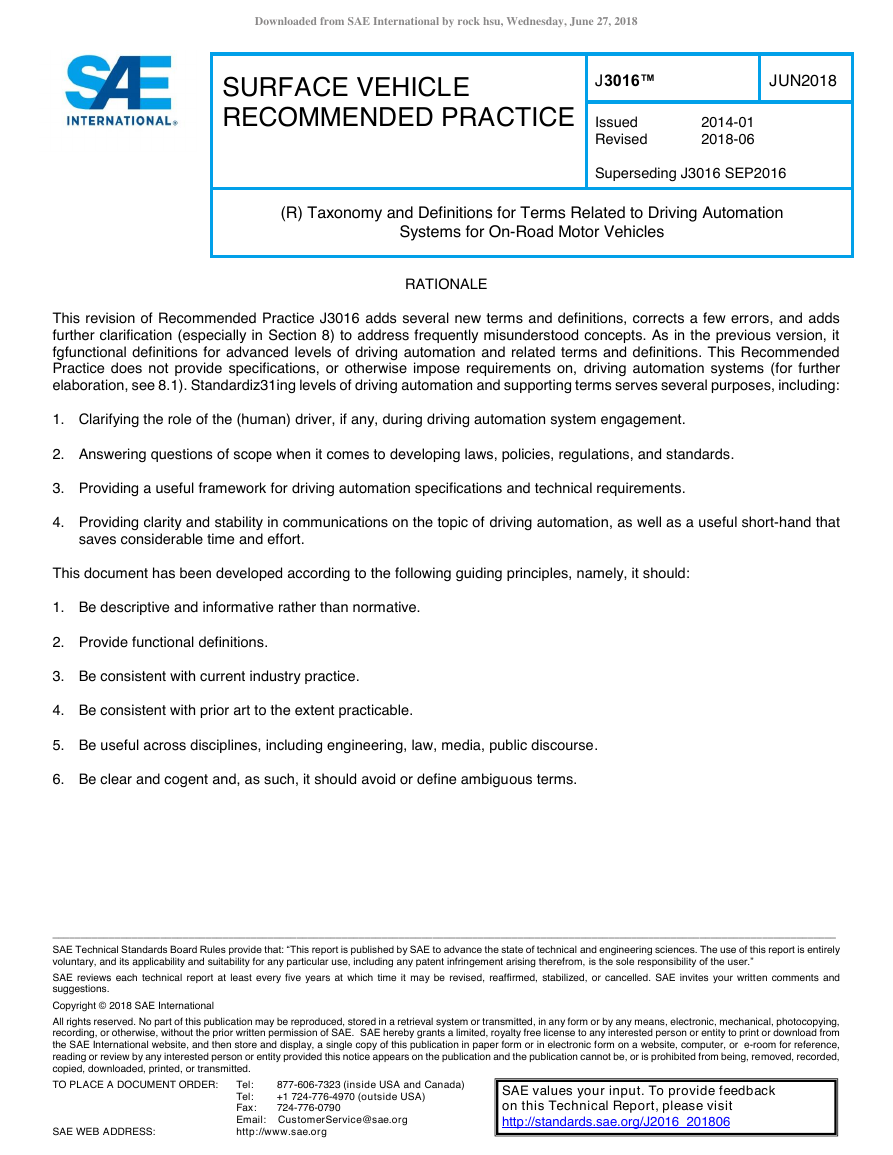
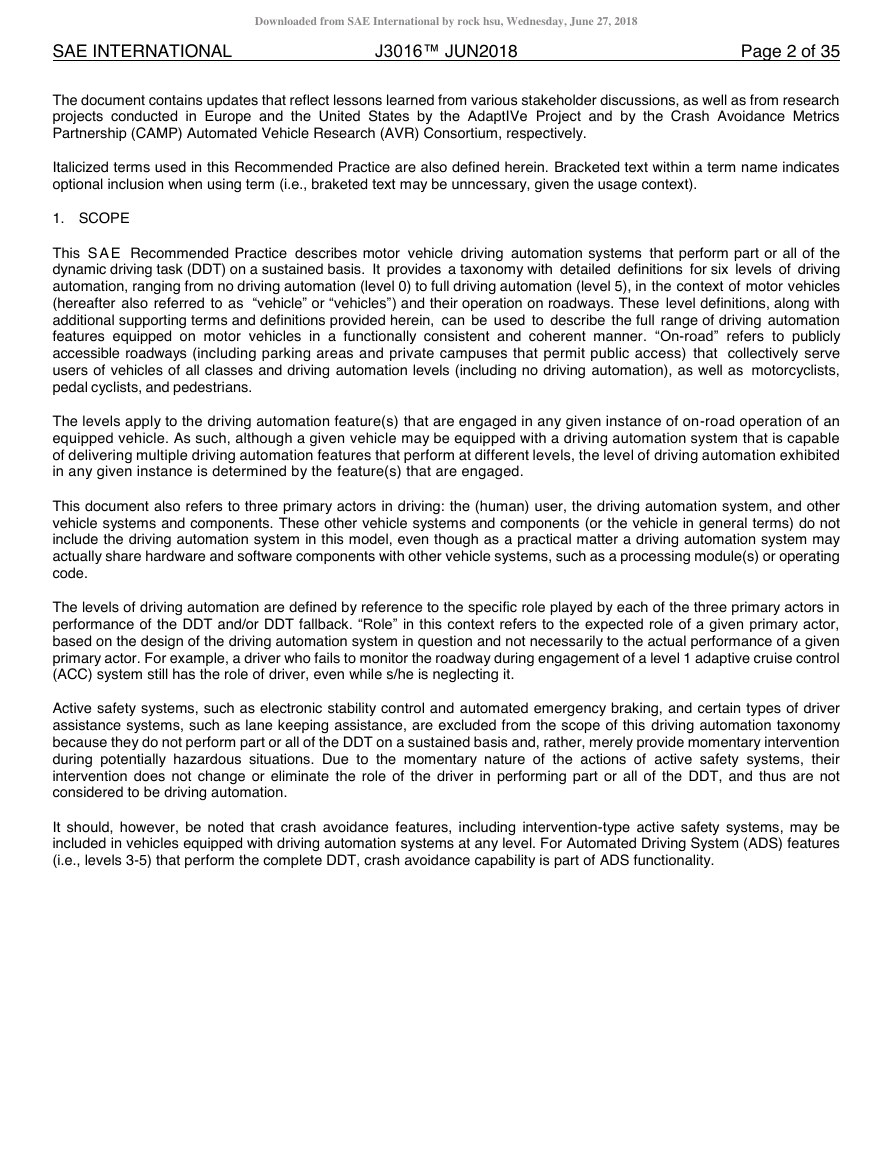
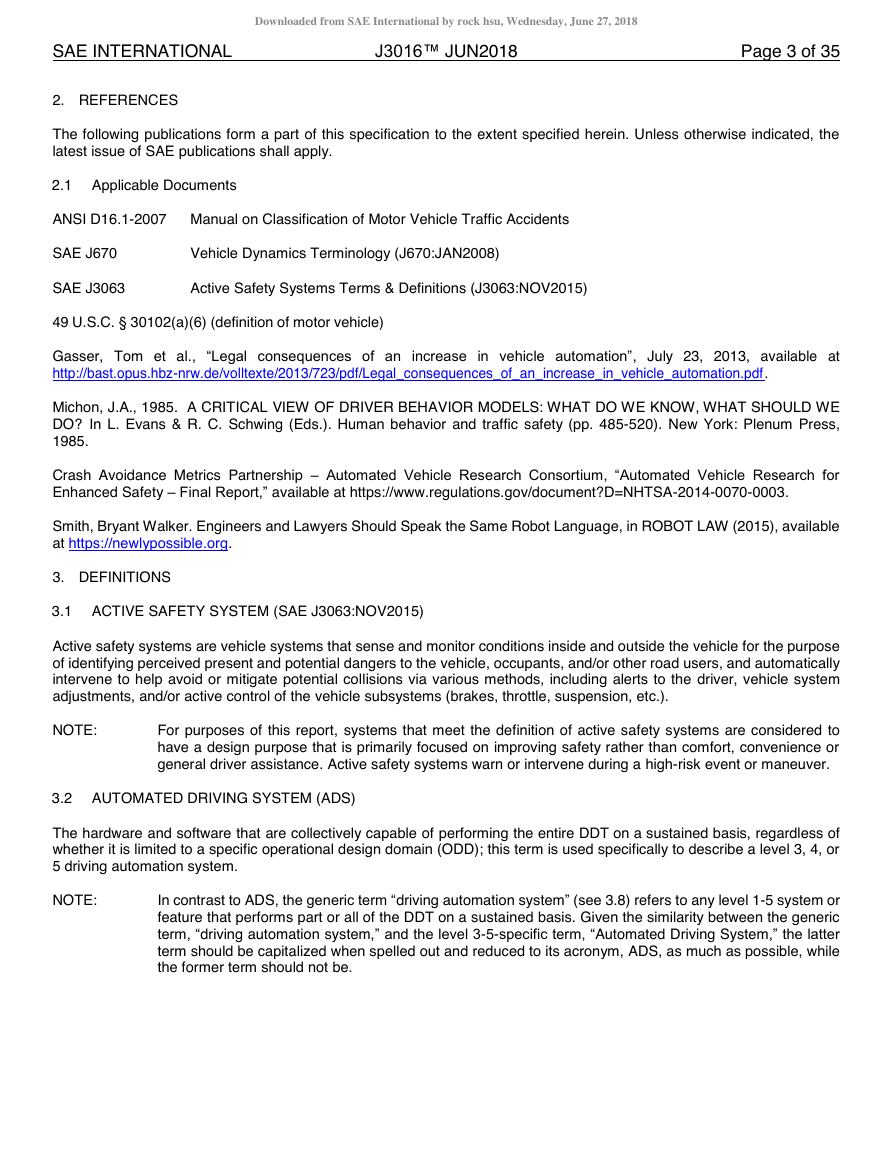
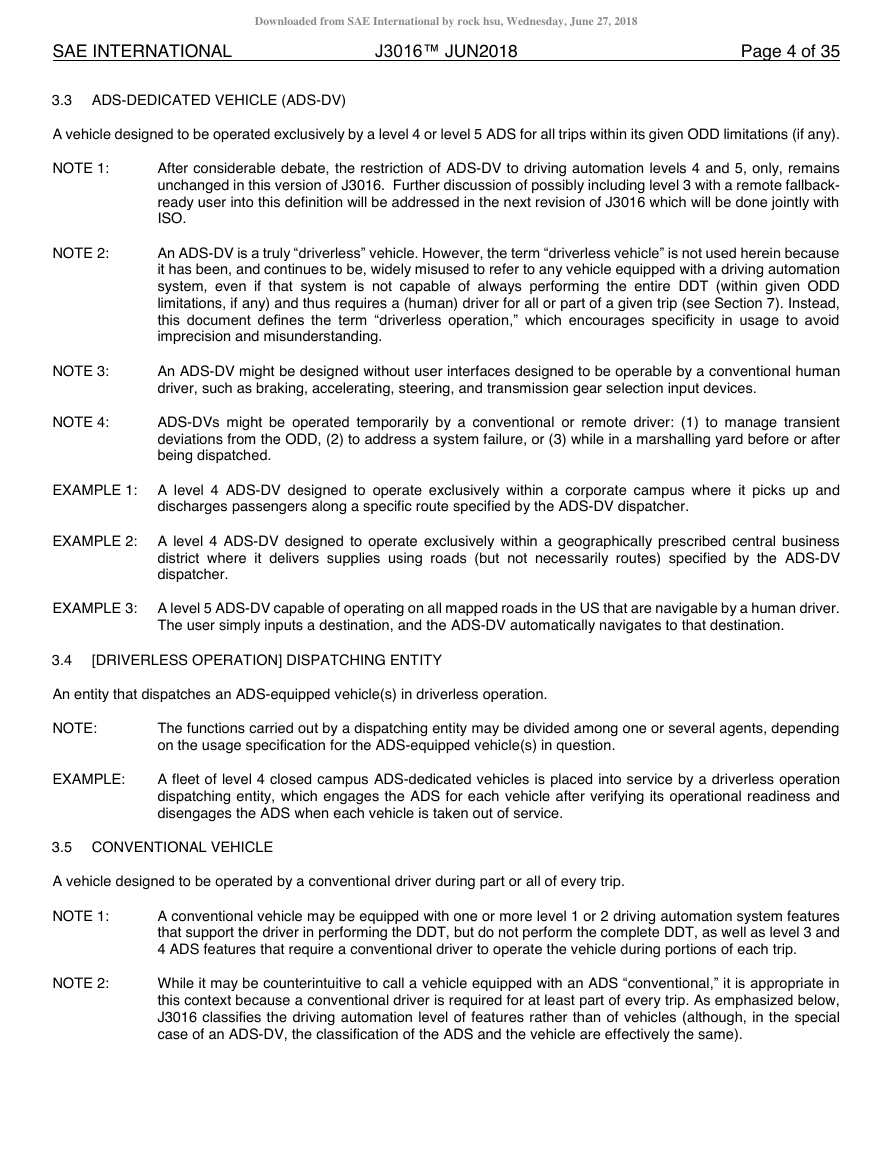
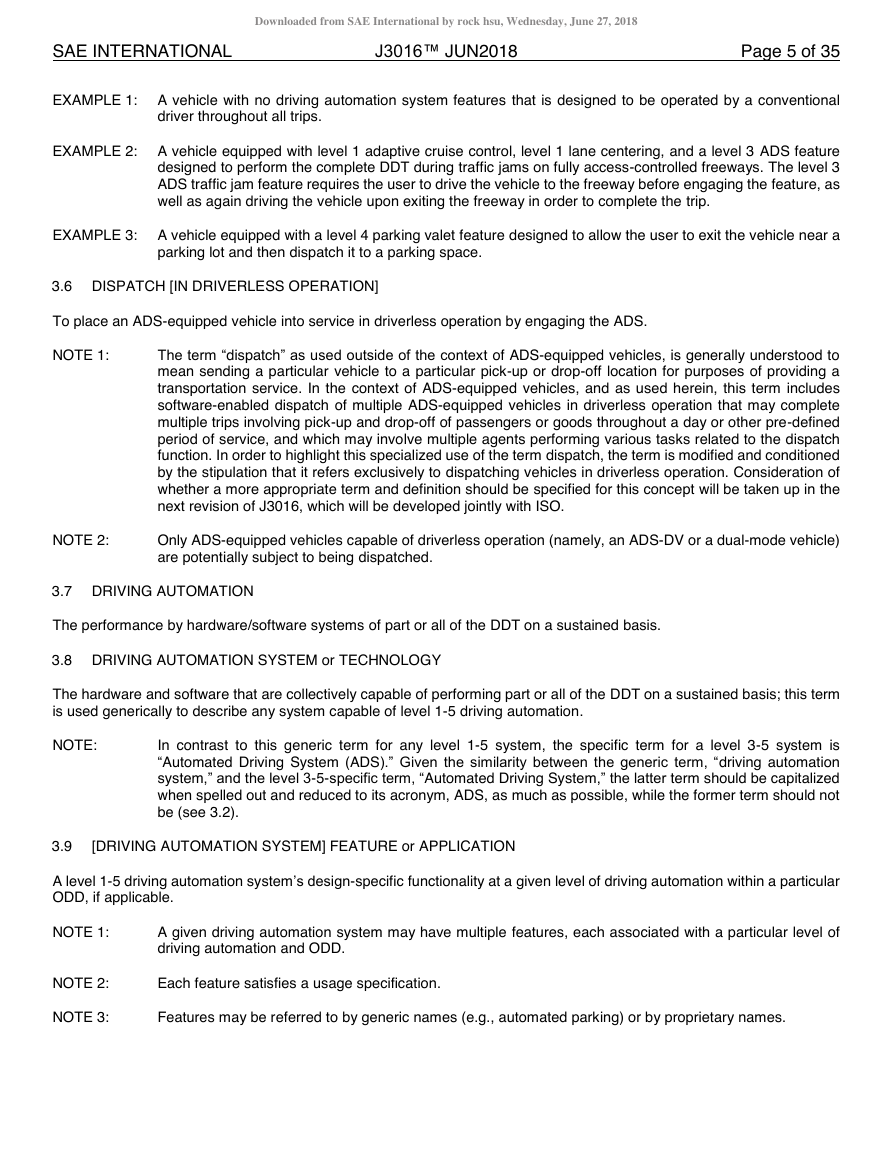
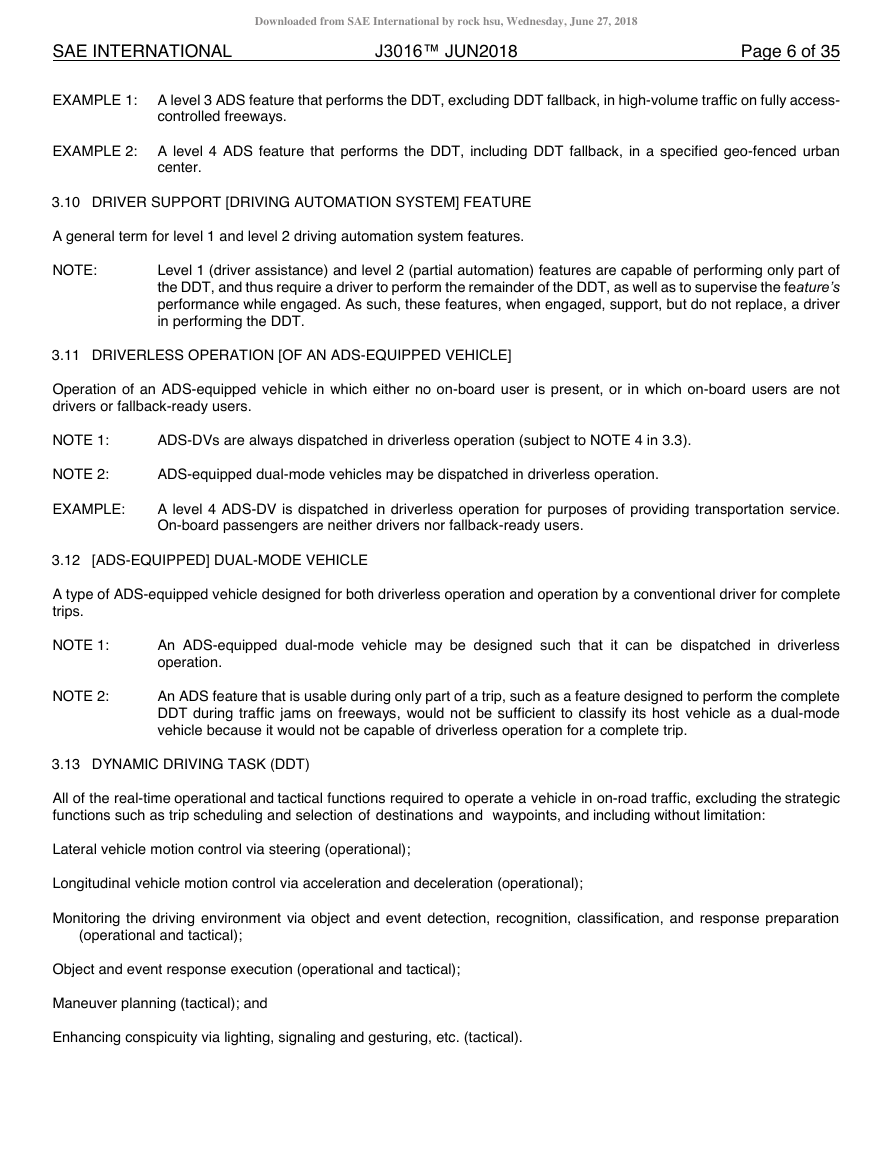
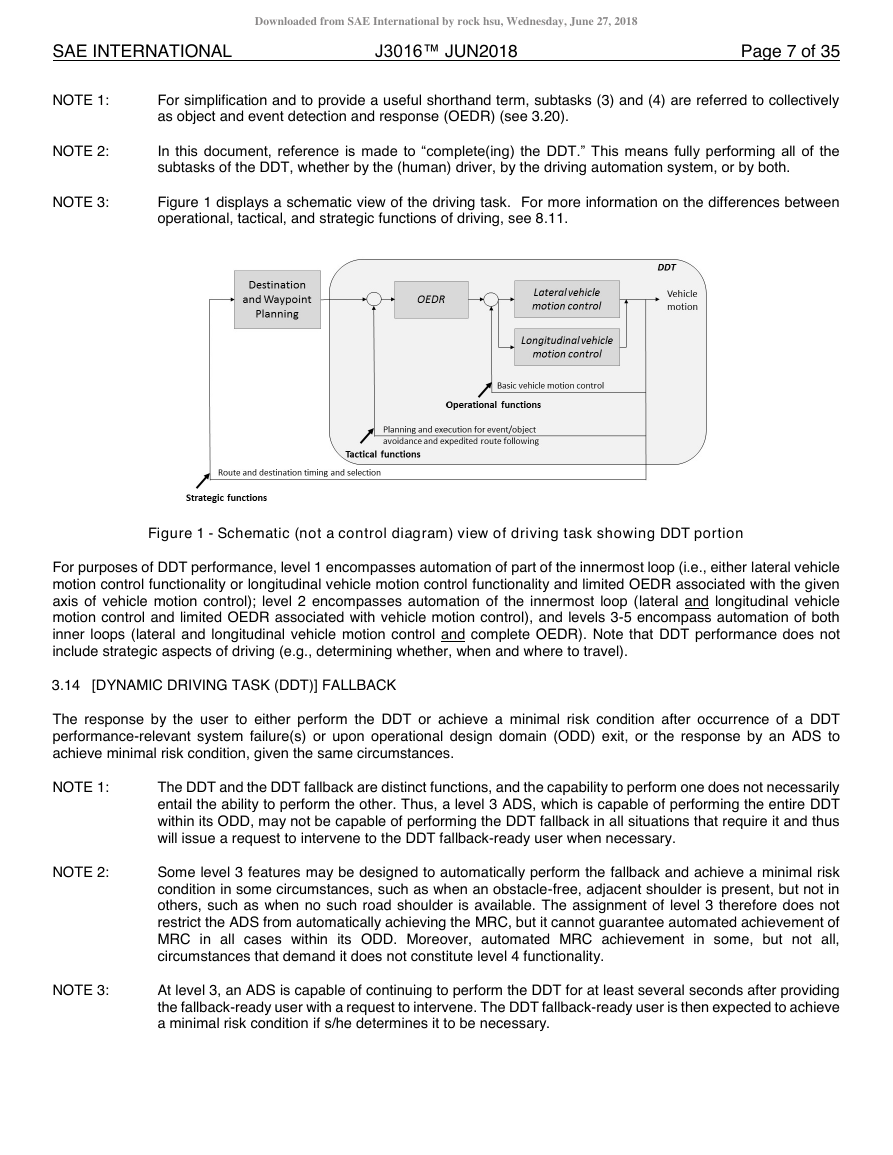









 2023年江西萍乡中考道德与法治真题及答案.doc
2023年江西萍乡中考道德与法治真题及答案.doc 2012年重庆南川中考生物真题及答案.doc
2012年重庆南川中考生物真题及答案.doc 2013年江西师范大学地理学综合及文艺理论基础考研真题.doc
2013年江西师范大学地理学综合及文艺理论基础考研真题.doc 2020年四川甘孜小升初语文真题及答案I卷.doc
2020年四川甘孜小升初语文真题及答案I卷.doc 2020年注册岩土工程师专业基础考试真题及答案.doc
2020年注册岩土工程师专业基础考试真题及答案.doc 2023-2024学年福建省厦门市九年级上学期数学月考试题及答案.doc
2023-2024学年福建省厦门市九年级上学期数学月考试题及答案.doc 2021-2022学年辽宁省沈阳市大东区九年级上学期语文期末试题及答案.doc
2021-2022学年辽宁省沈阳市大东区九年级上学期语文期末试题及答案.doc 2022-2023学年北京东城区初三第一学期物理期末试卷及答案.doc
2022-2023学年北京东城区初三第一学期物理期末试卷及答案.doc 2018上半年江西教师资格初中地理学科知识与教学能力真题及答案.doc
2018上半年江西教师资格初中地理学科知识与教学能力真题及答案.doc 2012年河北国家公务员申论考试真题及答案-省级.doc
2012年河北国家公务员申论考试真题及答案-省级.doc 2020-2021学年江苏省扬州市江都区邵樊片九年级上学期数学第一次质量检测试题及答案.doc
2020-2021学年江苏省扬州市江都区邵樊片九年级上学期数学第一次质量检测试题及答案.doc 2022下半年黑龙江教师资格证中学综合素质真题及答案.doc
2022下半年黑龙江教师资格证中学综合素质真题及答案.doc